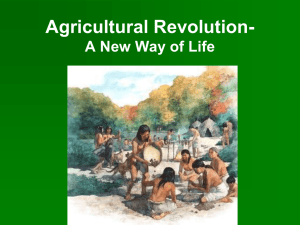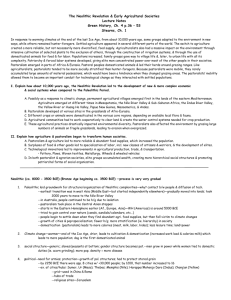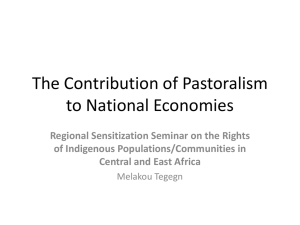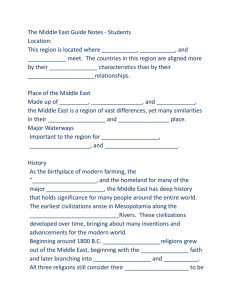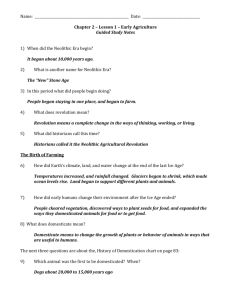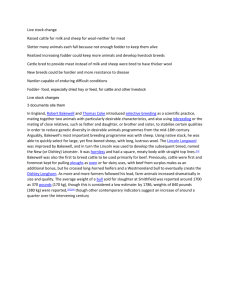Chapter 2: Later prehistory: Farming and Pastoralism in Tropical
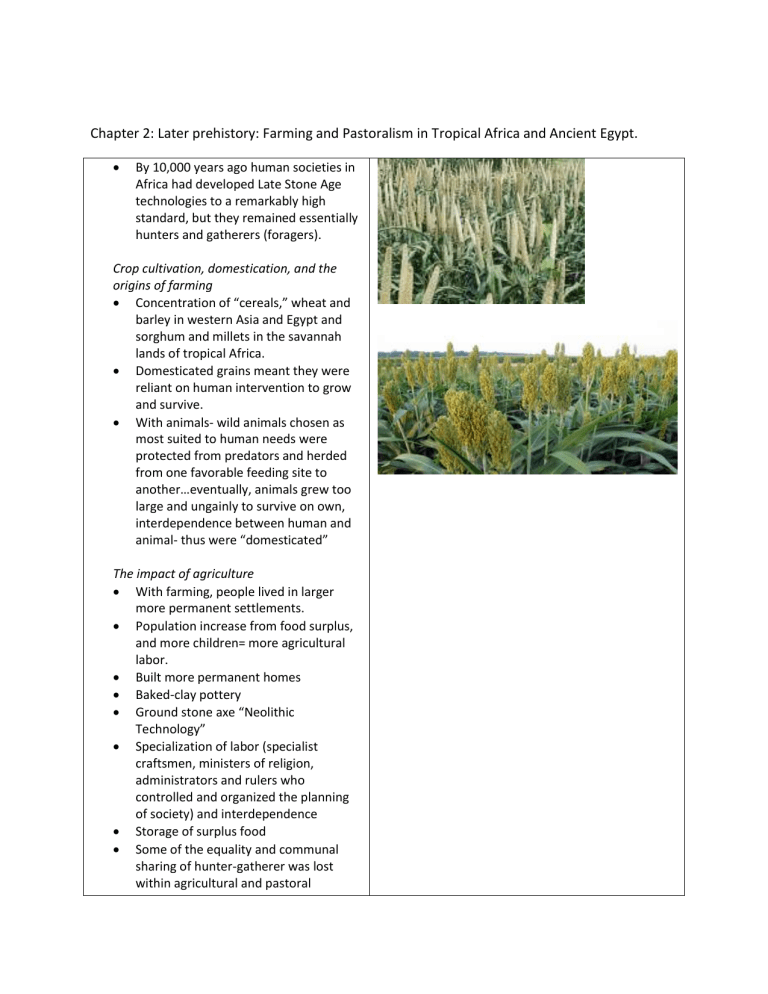
Chapter 2: Later prehistory: Farming and Pastoralism in Tropical Africa and Ancient Egypt.
By 10,000 years ago human societies in
Africa had developed Late Stone Age technologies to a remarkably high standard, but they remained essentially hunters and gatherers (foragers).
Crop cultivation, domestication, and the origins of farming
Concentration of “cereals,” wheat and barley in western Asia and Egypt and sorghum and millets in the savannah lands of tropical Africa.
Domesticated grains meant they were reliant on human intervention to grow and survive.
With animals- wild animals chosen as most suited to human needs were protected from predators and herded from one favorable feeding site to another…eventually, animals grew too large and ungainly to survive on own, interdependence between human and animal- thus were “domesticated”
The impact of agriculture
With farming, people lived in larger more permanent settlements.
Population increase from food surplus, and more children= more agricultural labor.
Built more permanent homes
Baked-clay pottery
Ground stone axe “Neolithic
Technology”
Specialization of labor (specialist craftsmen, ministers of religion, administrators and rulers who
controlled and organized the planning of society) and interdependence
Storage of surplus food
Some of the equality and communal sharing of hunter-gatherer was lost within agricultural and pastoral
societies.
Divisions between rich and poor developed with the existence of nonfood-producing classes and a growth in personal possessions…generally food producers remained poor
Pastoralism
Herding of domestic animals (cattle, sheep, goats)
***hint: think “pastures”
Animals used especially for milk, sometimes for meat.
Settlements tended to be less permanent- moved in search of seasonal pastures…still could live in large communities, due to steady food source from animals.
The ‘Agricultural Revolution’
Research in Africa has found that early moves towards crop cultivation may have been more gradual than previously thought.
Farming was not suitable in every environment
Farming could support a larger population, but it also left people more exposed to famine and natural disasters.
Example: Khoisan- adopted herding, but not cultivation
Africa’s indigenous religions are intertwined with the spiritual fertility of the land and the seasonal rituals of
‘rain-making’, cultivation, sowing and harvest.
The origins of farming and pastoralism in tropical Africa
9000BCE to 6000BCE –“wet phase” with increased rainfall, during which the rainforest expanded, deserts contracted and the Sahara became habitable as an open grassland savannah.
During the beginning of the wet phase were the origins of farming.
Nilo-Saharan Beginnings
From 9000BCE the Nilo-Saharans of eastern Sahara adopted the graincollecting and grinding practices of their northern neighbors, the Afro-Asiatics, and applied them to the tropical grasses of the middle Nile, sorghum and pearl millet.
Pottery by 8000BCE
Domesticated grains by 7000BCE
By 5000BCE: domesticated gourds and water-melons and cotton
Domesticated cattle by 8000BCE
The Importance of the tsetse fly in the early spread of pastoralism
Important factor in the spread of pastoralism in certain parts of tropical
Africa was the presence or absences of the blood-sucking insect called the tsetse fly.
A parasite carried in the saliva of certain tsetse causes “sleeping sickness”, a disease that can be fatal to humans and cattle.
Tsetse tended to congregate in moist low-lying valleys and thickly wooded regions.
Therefore, specialized pastoralism tended to develop in the drier open savannah grasslands of the southern
Sahara and the eastern and southern
African plateau.
The “Aquatic” culture of middle Africa
Nilo-Saharans during the wet period, also formed large fishing settlements around the expanded rivers and lakes of
‘middle Africa’, from the Niger Bend and
Lake Chad as far east as Lake Tirana.
Used bone harpoons, fish-traps and
shell hooks and pottery
Towards 5000BCE with end of wet phase, these large settlements were abandoned and people focused more on cultivation and herding.
Pastoralists of the Sahara
4000 to 2500 BCE- great age of pastoralism in the Sahara
Much information about the Saharan pastoralists comes from the rock paintings they left behind.
Paintings depict nearly every aspect of domestic life.
Huge herds of long-horned cattle as well as sheep.
Human figures show mixed
Mediterranean and negroid types.
Presence of grinding stones in their settlements suggest they also harvested grain.
Pastoralism and cultivation in north-east
Africa
North-east Africa, Afro-Asiatic Cushites
By 3500 BCE- Southern Cushites were herding cattle, sheep and goats south of the Ethiopian Highlands.
Cushites adopted cultivating practices and building practices of the Nilo-
Saharans- round thatched houses surrounding a central cattle kraal that
was enclosed within a hedge of thorns.
Afro-Asiatic speakers of Ethiopian highlands developed: tef (small seeded cereal still important in Ethiopia today); noog (an oil plant), and enset, (starchy fibrous stalks of a thick-stemmed banana-like plant).
Khoisan pastoralism in southern Africa
Khoisan probably learned sheep and cattle herding techniques from the
Cushites
By 0CE Khoe-speaking Khoisan were herding cattle as far south as the Cape of Good Hope.
Khoisan generally did not develop farming- perhaps because of high efficiency and wide range of hunting and gathering technology and skills they had developed.
Farming in West Africa
Niger-Congo peoples of West Africa developed agriculture during the wet phase, especially YAMS.
Stone axes
Oil palm for oil and wine, peas, groundnuts, and kola nut
By 3000BCE- domesticated guinea-fowl and were growing raffia palm for making raffia cloth
Upper Niger- wetlands- west African rice later spread to high-rainfall forest margins of Guinea, Liberia, and Cote d’Ivoire
Women were the main planters of yams in Niger-Congo culture.
High status of women- matrilineal descent among the Niger-Congo peoples.
Matrilineal system: positions of leadership and power in class and village are held by men, but these are inherited from the female line, from mothers and sisters.
Eastern branch of the Niger-Congo language family, Bantu-speakers, began moving into the rainforest of southeastern Nigeria and Cameroon…dug-out canoes, riverside settlements, goats, guinea-fowl, yams and palm-oil
